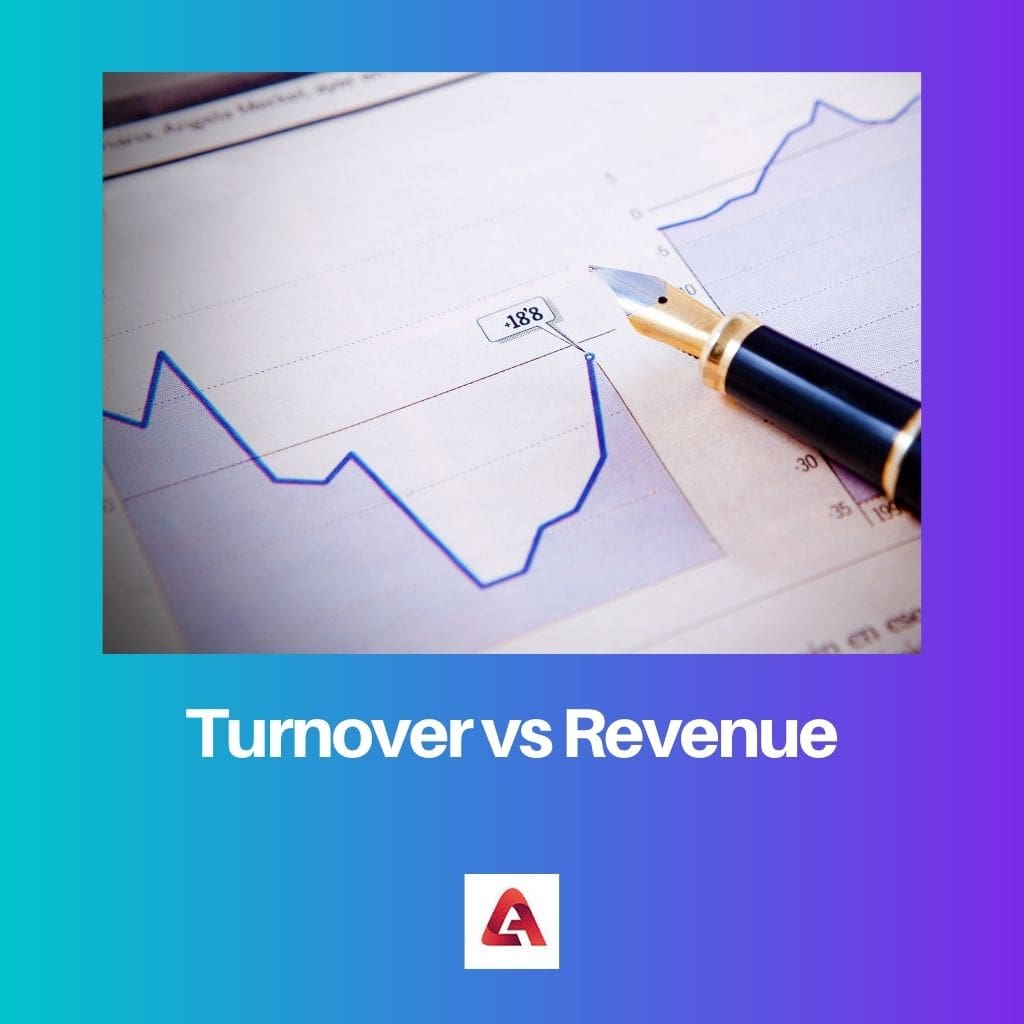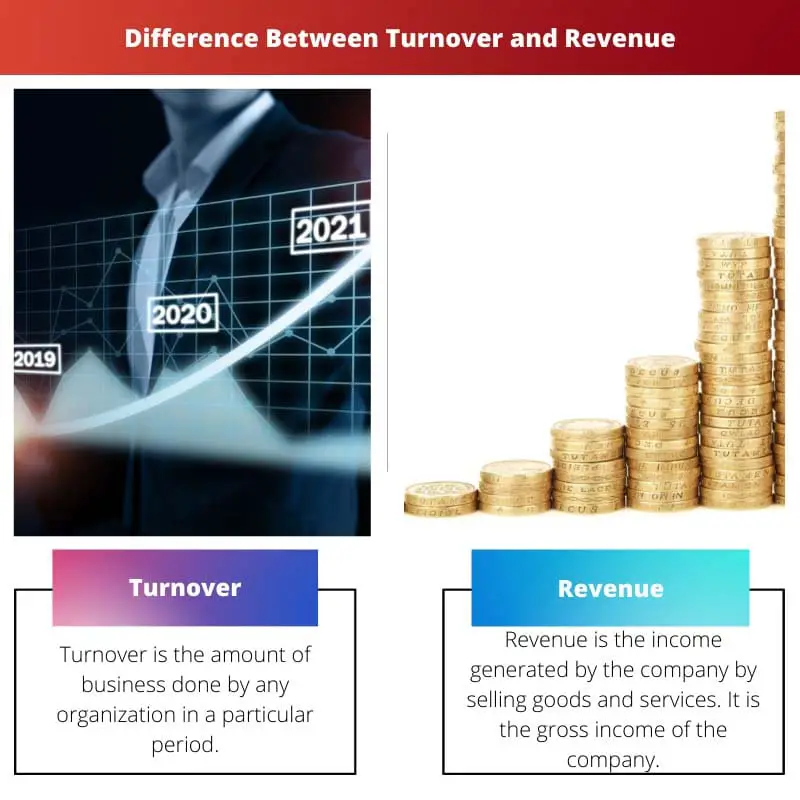Turnover and revenue are often used interchangeably, but they can have nuanced differences. Revenue generally refers to the total income generated from sales of goods or services. On the other hand, turnover is a broader term that encompasses not only revenue but also includes the total business activity, considering assets and liabilities.
Key Takeaways
- Context: Turnover is used to describe business performance, while revenue refers to Income generated by a company.
- Components: Turnover includes sales, investments, and other income sources; revenue is primarily Income from sales or services.
- Employee perspective: Turnover can also refer to the rate at which employees leave and are replaced within an organization unrelated to revenue.
Turnover vs Revenue
Turnover refers to the total value of goods or services sold by a company during a particular period and is the total amount of money that a company generates from sales. Revenue refers to the income a company generates from its primary business activities and is called “top-line revenue”.

Revenue broadly defines the profitability of a company that it gains by selling its goods at a particular price to consumers. This revenue further establishes the growth of a specific company in the market.
Turnover decides the organisation’s efficiency because turnover is the accounting concept that calculates how quickly any organization conducts its operations.
Comparison Table
| Feature | Turnover | Revenue |
|---|---|---|
| Meaning | Total value of sales made by a business in a specific period | Income generated from selling goods or services during normal business operations |
| Focus | Efficiency and activity level | Profitability |
| Calculation | Not a single calculation, can refer to inventory turnover (Cost of Goods Sold / Average Inventory) or cash turnover (Sales / Average Cash Balance) | Total sales made during a period, minus any returns or discounts |
| Types | Can refer to inventory, cash, or labor turnover | Divided into operating (core business activities) and non-operating (income from investments) |
| Analysis | Used to assess how quickly assets are converted into cash or how efficiently resources are utilized | Used to understand a company’s top line (gross income) and growth potential |
What is Turnover?
Turnover, in a business context, refers to the rate at which employees leave a company and are replaced by new hires. It is a critical metric that organizations monitor closely as it can have significant implications for productivity, morale, and overall business performance.
Factors Influencing Turnover
Several factors contribute to employee turnover, and understanding these elements is essential for organizations aiming to create a stable and productive work environment.
1. Job Satisfaction:
Job satisfaction plays a pivotal role in influencing turnover. Employees who are content with their work environment, responsibilities, and company culture are less likely to seek opportunities elsewhere.
2. Work-Life Balance:
A healthy work-life balance is crucial for employee retention. Companies that prioritize and support a balance between professional and personal life tend to experience lower turnover rates.
3. Compensation and Benefits:
Competitive compensation and comprehensive benefits packages are key factors in retaining top talent. When employees feel adequately rewarded for their contributions, they are more likely to stay with the organization.
4. Career Development Opportunities:
Employees seek growth and advancement in their careers. Companies that provide clear paths for career development and opportunities for skill enhancement are better positioned to retain their workforce.
5. Management and Leadership:
The quality of management and leadership within an organization significantly influences turnover. Employees are more likely to stay when they have supportive and effective leaders.
Types of Turnover
Understanding the different types of turnover helps organizations categorize and address the reasons behind employee departures.
1. Voluntary Turnover:
Voluntary turnover occurs when employees choose to leave the organization willingly. Reasons may include pursuing better opportunities, dissatisfaction, or personal reasons.
2. Involuntary Turnover:
Involuntary turnover refers to situations where employees are asked or required to leave the company. This can result from performance issues, restructuring, or other organizational changes.
3. Functional Turnover:
Functional turnover happens when employees leave to pursue career opportunities more aligned with their skills and interests. While it can be challenging, it may also lead to a more motivated and capable workforce.
4. Dysfunctional Turnover:
Dysfunctional turnover occurs when high-performing and valuable employees leave, negatively impacting the organization. Identifying and addressing the root causes is crucial to minimizing dysfunctional turnover.
Impact of Turnover
The consequences of turnover extend beyond the immediate loss of talent. Understanding its broader impact is essential for organizations seeking to mitigate its effects.
1. Financial Impact:
High turnover can incur significant costs related to recruitment, onboarding, and training. Moreover, the loss of institutional knowledge may impact productivity.
2. Morale and Productivity:
Frequent turnover can negatively affect the morale and productivity of the remaining workforce. It creates uncertainty and disrupts team dynamics.
3. Company Reputation:
Excessive turnover may harm a company’s reputation. Potential employees may be hesitant to join an organization with a history of high turnover.
4. Innovation and Creativity:
A stable workforce is more likely to foster innovation and creativity. High turnover may hinder the development of a collaborative and innovative work environment.
Managing Turnover Effectively
To address turnover, organizations can implement strategic measures to improve retention and create a positive work environment. These may include:
1. Employee Engagement Programs:
Implementing programs that enhance employee engagement and satisfaction can positively impact turnover rates.
2. Competitive Compensation and Benefits:
Regularly reviewing and adjusting compensation and benefits packages ensures they remain competitive in the market.
3. Professional Development Opportunities:
Providing continuous learning opportunities and career development programs can motivate employees to stay and grow within the organization.
4. Effective Leadership Training:
Investing in leadership development helps create a positive and supportive management structure, reducing the likelihood of turnover.
What is Revenue?
Revenue is a crucial financial metric that represents the total income generated by a business from its primary operations. It serves as a key indicator of a company’s financial performance and is a fundamental component in various financial analyses. Understanding revenue is essential for businesses, investors, and analysts to evaluate the company’s ability to generate income and sustain its operations.
Definition of Revenue
Revenue, also known as sales or turnover, is the total amount of money generated by a business through the sale of goods or services. It is the top line of the income statement and does not account for costs and expenses associated with producing and delivering those goods or services.
Types of Revenue
- Operating Revenue: This includes revenue generated from the core business activities, such as sales of products or services.
- Non-Operating Revenue: Income derived from sources outside the primary business operations, such as interest, investments, or the sale of assets.
- Recurring Revenue: Income that a business can expect to receive regularly, often from subscription-based services or long-term contracts.
- Non-Recurring Revenue: One-time or irregular income that is not expected to repeat, such as proceeds from the sale of a major asset.
Calculation of Revenue
The formula for calculating revenue is straightforward:
Revenue=Number of Units Sold×Price per Unit
This formula can be applied to both product and service-based businesses, where the number of units sold and the price per unit may vary.
Importance of Revenue
- Financial Health Indicator: Revenue is a primary indicator of a company’s financial health and performance. Higher revenue generally reflects a healthier and more successful business.
- Profitability Assessment: While revenue is essential, it does not directly represent a company’s profitability. Net profit, calculated by subtracting all expenses from revenue, provides a more accurate picture of financial success.
- Investor Confidence: Investors often use revenue growth as a key factor when assessing a company’s potential. Consistent or increasing revenue can instill confidence in investors.
- Strategic Decision-Making: Understanding revenue patterns helps businesses make informed decisions about pricing, marketing strategies, and resource allocation.
Challenges in Revenue Recognition
- Recognition Timing: Determining when to recognize revenue can be complex, especially for long-term contracts or when goods and services are delivered over time.
- Accounting Standards: Compliance with accounting standards, such as the International Financial Reporting Standards (IFRS) or Generally Accepted Accounting Principles (GAAP), can pose challenges in accurately reporting revenue.
- Changing Business Models: Businesses adopting new models, such as subscription-based services, may face challenges in recognizing revenue over the duration of the customer relationship.

Main Differences Between Turnover and Revenue
- Definition:
- Turnover refers to the total business activity and includes all sales, whether they are cash or credit transactions. It encompasses the entire value of goods and services sold by a company within a specific period.
- Revenue, on the other hand, specifically refers to the income generated from the sale of goods or services. It represents the money received or receivable by a company from its customers.
- Scope:
- Turnover is a broader term that includes not only revenue but also other sources of income, such as interest, royalties, and dividends.
- Revenue is a subset of turnover, focusing solely on the income derived from the primary business activities of selling goods or services.
- Components:
- Turnover may include various components like sales, interest income, dividend income, and other business activities.
- Revenue is more narrowly defined and consists only of the earnings directly related to the core business operations.
- Usage:
- Turnover is a term commonly used in Europe and is often synonymous with revenue.
- Revenue is the more widely used term in the United States to describe the income generated from the primary business operations.
- Accounting Standards:
- Turnover is a term commonly used in the context of financial reporting based on International Financial Reporting Standards (IFRS).
- Revenue is the term predominantly used in financial reporting based on Generally Accepted Accounting Principles (GAAP) in the United States.
- Calculation:
- Turnover may involve a more comprehensive calculation that considers all forms of business activities.
- Revenue is a straightforward calculation based on the sales of goods or services.
- Perspective:
- Turnover provides a more holistic view of a company’s overall business activity and its ability to generate income from various sources.
- Revenue is a more focused metric, emphasizing the primary source of income related to the core business operations.

- https://eprints.lse.ac.uk/64916/1/Spinnewijn_Production%20versus%20Revenue%20Efficiency.pdf
- https://anesthesiology.pubs.asahq.org/article.aspx?articleid=1942223&resultclick=1

The detailed analysis of the components and impact of turnover and revenue is fantastic. It offers a well-rounded perspective on these essential financial concepts.
Absolutely, Bethany. It’s impressive to see such a comprehensive exploration of these financial terms.
I completely agree, Bethany. The depth of analysis in this article is truly insightful.
The sections on ‘What is Turnover?’ and ‘What is Revenue?’ provided a comprehensive overview of these financial concepts. It’s great to have all the information in one place like this.
Absolutely, Barry. The depth of explanation in this article is commendable.
The main differences between turnover and revenue are articulated with utmost clarity in this article. It’s certainly a valuable resource for those seeking to enhance their financial knowledge.
Well said, Matthew. This article’s detailed approach helps in establishing a solid understanding of turnover and revenue.
Absolutely, Matthew. The precision and accuracy in explaining these financial terms are commendable.
The comparison table provided is quite helpful in understanding the differences between turnover and revenue. It’s a great resource for anyone looking to grasp these financial concepts.
I completely agree, Jason. The table simplifies the comparisons and highlights the importance of both turnover and revenue.
This article is really informative! I appreciate the clear distinction made between turnover and revenue. It’s important to understand the financial terms correctly.
I completely agree! Understanding financial terms like these is crucial for business success.
The detailed explanation of the main differences between turnover and revenue is very enlightening. It’s an excellent guide for anyone seeking clarity on these financial terms.
Agreed, Ken. This article really breaks down the distinctions in a way that’s easy to understand.
I think the article effectively captures the essence of turnover and revenue, making it accessible for readers from various backgrounds.
I found it interesting to learn about the varied terminologies of ‘turnover’ in different sectors such as accounting, finance, and human resource management. It just shows how versatile the concept is!
Absolutely, Olivia. It’s fascinating to see how the concept of turnover is applied across different fields.
The article provides an excellent breakdown of the key differences between turnover and revenue. It’s a must-read for anyone aiming to expand their understanding of financial terminology.
The explanations provided for both turnover and revenue are very clear and concise. It helps to have a solid understanding of these concepts for effective financial decision-making.
Well said, Lexi. This article provides valuable insights into the financial aspects of business.
Absolutely, these distinctions are important for companies to manage their operations efficiently and enhance profitability.
The article effectively elucidates the importance, impact, and uses of both turnover and revenue. It’s a valuable resource for anyone looking to gain insights into financial management.
I couldn’t agree more, Oliver. This article offers a holistic view of both concepts, which is beneficial for professionals and students alike.
Absolutely, Oliver. The thorough explanations provide clarity on how these financial terms play crucial roles in business operations.